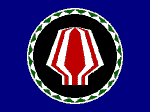Bougainville |
|
|
|
| Übersicht – Contents: | |
Diese Seite ist Teil des Projektes
Bougainville |
|
|
|
| Übersicht – Contents: | |
Flagge – Flag: |
|
 |
Nationalflagge – national flag, Quelle/Source nach/by: UNPO, ca. 2010 |
Bedeutung/Ursprung der Flagge – Meaning/Origin of the Flag: |
|
| Die Flagge von Bougainville ist einfarbig blau und zeigt in der Mitte eine schwarze Scheibe mit einem weißen grün-gezackten Rand. In der Mitte der schwarzen Scheibe die stilisierte Darstellung eines Ritual-Hutes. Blau ist die Farbe des Ozeans, Grün steht für die üppige Vegetation, Schwarz für die Menschen und ihre Hautfarbe. Die weiße Umrandung repräsentiert eine bestimmte Art von Muscheln, die auf der Insel früher als Zahlungsmittel verwendet wurden. Der Ritual-Hut wird von männlichen Jugendlichen getragen, wenn sie in die Reihen der Erwachsenen aufgenommen werden. | The flag of
Bougainville is single-coloured blue and shows in the middle a black disk with a white
green-jagged border. In the middle of the black disk a stylized depiction of a ritual hat. Blue is the colour of the ocean, green stands for the abundant vegetation, black for the people and their skin colour. The white border represents a special kind of conches which were formerly used on the island as currency. The ritual hat is pulled on by the masculine adolescents if they become incorporated into the rows of the adults. |
| Quelle/Source nach/by: Flags of the World | |
| Landkarte – Map: |
|
Zahlen und Fakten – Numbers and Facts: |
|
|
|
|
|
|
|
|
|
|
|
|
|
|
|
|
|
|
Geschichte: |
| 1568
· Inbesitznahme durch Spanien, keine Kolonisierung 1768 · Wiederentdeckung durch den französichen Seefahrer Antoine de Bougainville 1884 · Inbesitznahme durch die Deutsche Neuguinea-Kompanie 1899 · Übernahme durch das Deutsche Reich 1921 · Verwaltung durch Australien 1942–1944 · im Zweiten Weltkrieg von Japan besetzt 1975 · Angliederung an Papua-Neuguinea als North Solomons Province seit 1974 · starke Umweltzerstörung durch die Mine Panguna 1979 · erste Unruhen wegen Panguna 1980 · Straßenkämpfe 1988 · Bürgerkrieg (Befreiungsarmee von Bougainville, BRA, Bougainville Revolutionary Army) 1990 · Unabhängigkeit 1990 · Stillegung von Panguna 1990 · Blockade durch Papua-Neuguinea fordert 15 000 Menschenleben 1994 · Waffenstillstand 1996 · Erneute Angriffe von Papua-Neuguinea 1997 · Waffenstillstand 1998 · vorläufiger Friedensvertrag mit Papua-Neuguinea 2001 · Friedensvertrag, Papua-Neuguinea gewährt offiziell Autonomie als Autonome Region Bougainville 2005 · Wahlen zur Provinzregierung, vom Widerstand teilweise boykottiert Dezember 2019 · ein Referendum egibt 98 % für die Unabhängigkeit |
History: |
| 1568
· appropriation by Spain, no Colonization 1768 · re-discovery by the French seafarer Antoine de Bougainville 1884 · appropriation by the German New Guinea Company 1899 · takeover by the German Empire 1921 · administration by Australia 1942–1944 · Occupied by Japan in World War II 1975 · annexation to Papua New Guinea as North Solomons Province since 1974 · considerable destructions of environment by the Panguna Mine 1979 · first agitations because of Panguna 1980 · street fights 1988 · civil war (Liberation Army of Bougainville, BRA, Bougainville Revolutionary Army) 1990 · independence 1990 · decommission of Panguna 1990 · blockade by Papua New Guinea demands 15 000 human lifes 1994 · armistice 1996 · once more attacks by Papua New Guinea 1997 · armistice 1998 · preliminary peace treaty with Papua New Guinea 2001 · peace treaty, Papua New Guinea grants officially autonomy as Autonomous Region of Bougainville 2005 · elections for the provincial government, boycotted by the opposition in part December 2019 · a referendum gives 98% in favour of independence |
| Quelle/Source: nach/by Wikipedia (D) |
Ursprung des Landesnamens – Origin of the Country's Name: |
|
| Die Insel Bougainville ist benannt nach Louis Antoine de Bougainville (1729–1811), einen französischen Seefahrer. Er umsegelte (auf der Route von Magellan) als erster Franzose zwischen 1766 und 1769 die Welt. Dabei entdeckte er im Jahre 1768 die Inselgruppe der Salomonen wieder, deren Lage in Vergessenheit geraten war. Die Insel Bougainville ist die nördlichste Insel der größeren Inseln der Inselgruppe der Salomonen. | Bougainville Island is
named by Louis Antoine de Bougainville (1729–1811) a French seafarer. He sailed
around the world (on the route of Magalhães) between 1766 and 1769 as first Frenchman.
During that he discovered in 1768 again the Archipelago of the Solomon Islands. Its
position was fallen into oblivion. Bougainville Island is the most northern island of the
greater islands of the Archipelago of the Solomon Islands. |
| Quelle/Source: Handbuch der geographischen Namen | |